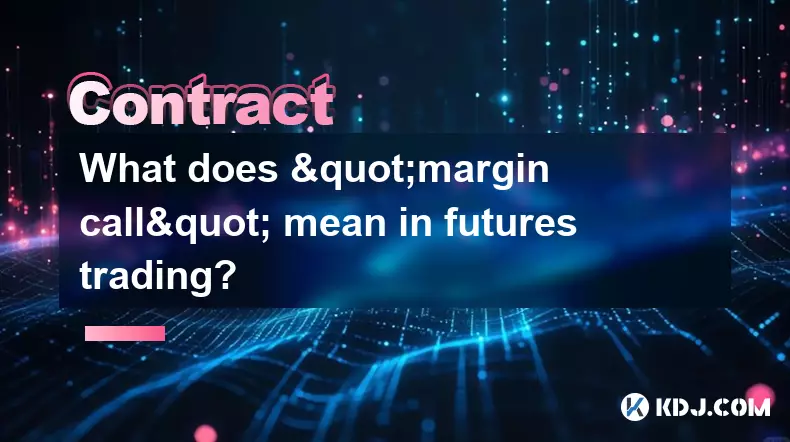-
 bitcoin
bitcoin $124586.364639 USD
0.62% -
 ethereum
ethereum $4670.671710 USD
3.33% -
 xrp
xrp $2.983701 USD
0.18% -
 tether
tether $1.000175 USD
-0.03% -
 bnb
bnb $1209.430642 USD
2.76% -
 solana
solana $231.365861 USD
0.51% -
 usd-coin
usd-coin $0.999665 USD
-0.02% -
 dogecoin
dogecoin $0.264657 USD
4.46% -
 tron
tron $0.346415 USD
1.60% -
 cardano
cardano $0.871586 USD
3.70% -
 chainlink
chainlink $23.451270 USD
7.56% -
 hyperliquid
hyperliquid $46.860071 USD
-2.96% -
 ethena-usde
ethena-usde $1.000120 USD
0.04% -
 sui
sui $3.611279 USD
1.08% -
 stellar
stellar $0.407149 USD
0.96%
What does "margin call" mean in futures trading?
A margin call in futures trading occurs when account equity falls below maintenance levels, requiring immediate funds to avoid position liquidation.
Sep 28, 2025 at 02:54 am

Understanding Margin Calls in Futures Trading
1. A margin call occurs when the value of an investor’s margin account falls below the broker’s required minimum level. This typically happens in futures trading where traders use leverage to control large positions with relatively small capital. When market movements go against their position, losses accumulate, reducing the equity in the account.
2. Brokers issue a margin call to prompt the trader to deposit additional funds or securities to restore the account to the minimum maintenance margin requirement. Failure to meet the margin call may result in the broker liquidating the trader’s positions to cover the deficit. This automatic liquidation is designed to protect both the broker and the broader market from excessive risk exposure.
3. The initial margin is the amount required to open a leveraged position, while the maintenance margin is the threshold that must be maintained to keep the position active. If ongoing losses reduce the account balance beneath this threshold, the margin call is triggered. Traders must act quickly to avoid forced exits at potentially unfavorable prices.
4. In fast-moving markets, price slippage can exacerbate the impact of a margin call. Even if a trader attempts to add funds, delays in processing or extreme volatility might lead to partial or full liquidation before the deposit clears. This makes real-time monitoring crucial for anyone engaged in leveraged futures trading.
5. Margin calls are not penalties but rather risk management tools used by exchanges and brokers. They ensure that traders maintain sufficient collateral to back their leveraged positions. Understanding how margin requirements work and managing risk accordingly is essential for sustainable participation in futures markets.
Risks Associated with High Leverage
1. Using high leverage amplifies both potential gains and potential losses. While it allows traders to control larger contracts with minimal upfront capital, it also increases the likelihood of triggering a margin call during adverse price movements.
2. A position opened with 10x or higher leverage can be wiped out by a relatively small percentage move in the wrong direction. For instance, a 10% drop in asset value on a 10x leveraged trade eliminates the entire initial margin, leading directly to a margin call.
3. High leverage reduces the buffer between the current equity and the maintenance margin level. This narrow margin leaves little room for price fluctuations, making the position highly sensitive to market volatility.
4. Many novice traders underestimate how quickly losses can accumulate under high leverage. Without proper stop-loss strategies or adequate capital reserves, they risk facing repeated margin calls or complete account depletion.
5. Exchanges often adjust leverage limits based on market conditions. During periods of high volatility, brokers may reduce allowable leverage or increase margin requirements, which can unexpectedly trigger margin calls even without significant price movement.
How Traders Can Prevent Margin Calls
1. Maintaining a healthy amount of excess margin beyond the minimum requirement provides a safety cushion against sudden price swings. This buffer reduces the probability of receiving a margin call during normal market fluctuations.
2. Setting stop-loss orders helps limit downside risk by automatically closing positions when prices reach predetermined levels. Though not foolproof due to slippage, stop-losses remain a key tool in preventing catastrophic drawdowns.
3. Diversifying across different assets or strategies can reduce overall portfolio risk. Concentrating all capital in a single leveraged futures contract increases vulnerability to margin calls if that particular market moves sharply against the position.
4. Regularly monitoring open positions allows traders to respond proactively to changing market conditions. Real-time alerts and margin tracking tools offered by most trading platforms support timely decision-making.
5. Avoiding maximum leverage usage gives more flexibility in managing trades. Opting for lower leverage ratios, such as 2x or 3x instead of 20x or 50x, significantly improves resilience against margin calls.
Common Questions About Margin Calls in Crypto Futures
What triggers a margin call in cryptocurrency futures?A margin call is triggered when the equity in a trader’s futures account drops below the maintenance margin level due to unrealized losses. This commonly occurs during sharp price reversals, especially in highly volatile crypto markets.
Can I avoid liquidation after a margin call?
Yes, if you deposit enough funds immediately to bring your account back above the maintenance margin requirement, you can prevent forced liquidation. However, speed is critical—delays may result in automatic position closure by the exchange.
Do all futures platforms issue margin calls?
Not all platforms operate the same way. Some exchanges use a tiered liquidation system or auto-deleverage mechanisms instead of traditional margin calls. Others provide partial liquidation or insurance funds to manage undercollateralized positions.
Is a margin call the same as being liquidated?
No. A margin call is a warning requesting additional funds. Liquidation occurs when the trader fails to meet the call, and the platform closes the position to recover the owed amount. In many cases, liquidation happens without prior notice once the margin ratio hits the liquidation threshold.
Disclaimer:info@kdj.com
The information provided is not trading advice. kdj.com does not assume any responsibility for any investments made based on the information provided in this article. Cryptocurrencies are highly volatile and it is highly recommended that you invest with caution after thorough research!
If you believe that the content used on this website infringes your copyright, please contact us immediately (info@kdj.com) and we will delete it promptly.
- BlockDAG, DOGE, HYPE Sponsorship: Crypto Trends Shaping 2025
- 2025-10-01 00:25:13
- Deutsche Börse and Circle: A StableCoin Adoption Powerhouse in Europe
- 2025-10-01 00:25:13
- BlockDAG's Presale Buzz: Is It the Crypto to Watch in October 2025?
- 2025-10-01 00:30:13
- Bitcoin, Crypto, and IQ: When Genius Meets Digital Gold?
- 2025-10-01 00:30:13
- Stablecoins, American Innovation, and Wallet Tokens: The Next Frontier
- 2025-10-01 00:35:12
- NBU, Coins, and Crypto in Ukraine: A New Yorker's Take
- 2025-10-01 00:45:14
Related knowledge

What is the difference between futures and perpetual contracts for Bitcoin?
Oct 02,2025 at 11:54pm
Understanding Bitcoin Futures Contracts1. Bitcoin futures are derivative instruments that allow traders to speculate on the future price of Bitcoin at...

What is the best time to trade PEPE contracts?
Oct 03,2025 at 11:54am
Understanding PEPE Contract Volatility1. PEPE contracts exhibit extreme price fluctuations due to their meme-based nature and low market cap. Trading ...

What are the common mistakes to avoid with Bitcoincoin contracts?
Oct 03,2025 at 08:54am
Emerging Trends in the Cryptocurrency Market1. Decentralized finance (DeFi) platforms continue to expand their influence across the blockchain ecosyst...

What is the maintenance margin for Bitcoin contracts?
Oct 02,2025 at 01:36am
Decentralized Exchanges Gain Momentum in 20241. Decentralized exchanges (DEXs) have seen a significant rise in trading volume, surpassing centralized ...

How to use technical analysis for trading XRP contracts?
Oct 03,2025 at 01:18pm
Understanding Price Patterns in XRP Futures1. Identifying chart patterns such as triangles, head and shoulders, and double tops or bottoms can provide...

What does "longing" PEPE contracts mean?
Oct 03,2025 at 11:54pm
Understanding Decentralized Exchanges in the Crypto Ecosystem1. Decentralized exchanges (DEXs) operate without a central authority, allowing users to ...

What is the difference between futures and perpetual contracts for Bitcoin?
Oct 02,2025 at 11:54pm
Understanding Bitcoin Futures Contracts1. Bitcoin futures are derivative instruments that allow traders to speculate on the future price of Bitcoin at...

What is the best time to trade PEPE contracts?
Oct 03,2025 at 11:54am
Understanding PEPE Contract Volatility1. PEPE contracts exhibit extreme price fluctuations due to their meme-based nature and low market cap. Trading ...

What are the common mistakes to avoid with Bitcoincoin contracts?
Oct 03,2025 at 08:54am
Emerging Trends in the Cryptocurrency Market1. Decentralized finance (DeFi) platforms continue to expand their influence across the blockchain ecosyst...

What is the maintenance margin for Bitcoin contracts?
Oct 02,2025 at 01:36am
Decentralized Exchanges Gain Momentum in 20241. Decentralized exchanges (DEXs) have seen a significant rise in trading volume, surpassing centralized ...

How to use technical analysis for trading XRP contracts?
Oct 03,2025 at 01:18pm
Understanding Price Patterns in XRP Futures1. Identifying chart patterns such as triangles, head and shoulders, and double tops or bottoms can provide...

What does "longing" PEPE contracts mean?
Oct 03,2025 at 11:54pm
Understanding Decentralized Exchanges in the Crypto Ecosystem1. Decentralized exchanges (DEXs) operate without a central authority, allowing users to ...
See all articles










































































